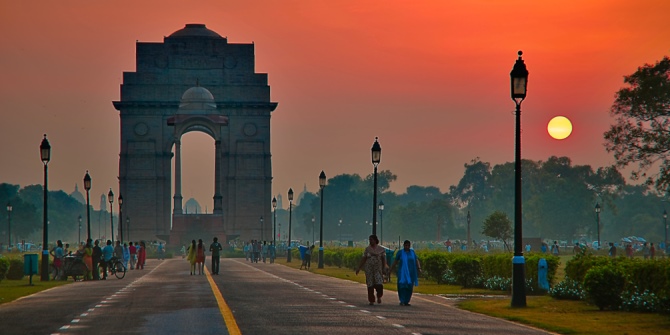 Sustainable and inclusive growth is once again the over-arching priority for India in 2016, but in the wake of the Paris Climate Conference environmental sustainability is also being given greater attention, writes Ruth Kattumuri. Improving technology governance, developing infrastructure, harnessing the young population and ensuring the benefits of development are evenly distributed between urban and rural areas, as well as different states, will also be key to achieving India’s ambitious growth goals going forward.
Sustainable and inclusive growth is once again the over-arching priority for India in 2016, but in the wake of the Paris Climate Conference environmental sustainability is also being given greater attention, writes Ruth Kattumuri. Improving technology governance, developing infrastructure, harnessing the young population and ensuring the benefits of development are evenly distributed between urban and rural areas, as well as different states, will also be key to achieving India’s ambitious growth goals going forward.
1. Sustainable and inclusive growth: India has to set itself an ambitious growth rate target of 10% to adequately meet the requirements for sustainable and inclusive growth of her 1.29 billion people. Estimates for India’s GDP growth average around 7.5%, which is an essential base growth rate to pursue the goals and priorities for the country’s development. India’s steady growth also offers a spark for supporting global growth. Its success is therefore in the interests of other countries in the region and beyond.
Significant challenges for sustainable and inclusive economic and social development continue to persist within India, such as the fiscal deficit, slowing private sector investment and industrial credit, and decelerating capital goods imports. Low carbon green growth, infrastructure development and entrepreneurship through national and international collaborations provide valuable opportunities for sustainable growth. India’s young and rapidly growing working age population also presents both an opportunity and a challenge, depending on how effectively it can be harnessed.
2. Environmental sustainability: Low carbon green growth and environmental protection is inevitable. An immediate priority for India is to improve the air quality in urban areas, as it is having a negative impact on life expectancy. Faster and stronger policies (including improvement of public transport) are therefore required across all major cities to tackle air pollution.

India’s Intended Nationally Determined Contributions (INDCs) submitted before COP21 in Paris include commitments to reduce emissions intensity by 33-35% by 2030 compared to 2005 levels through introducing, new, more efficient, cleaner and renewable technologies; produce 40% of electricity from non-fossil fuel based energy resources; create additional carbon sink of 2.5-3 billion tonnes of carbon dioxide equivalent through additional forest and tree cover; and develop robust adaptation strategies for agriculture, water and health sectors.
The record number of at least 1000 deaths due to heat waves during summer, and the floods in Chennai in December 2015, provide learning that long term planning and policies for sustainable development are essential to mitigate risks and challenges due to climate change. Estimates suggest that at least $2.5 trillion will be required for meeting India’s climate change action plans to 2030 and she will need to spend around $206 billion for implementing essential adaptation programmes in agriculture, forestry, fisheries infrastructure, water resources and ecosystems. But these projects will also provide opportunities to enhance growth, create employment and provide better and healthier living standards.
3. Technology governance: This is a public policy concept with an aim to develop knowledge-based, transparent and efficient systems for sustainable economic growth and greater social cohesion. Technology governance is therefore crucial to transform growth and development in the evolving processes and politics of government (centre and state), private institutions, media, non-governmental institutions and society in India.
The large scale food security and various other social security programmes for poverty alleviation in the country struggle with concerns of implementation, with leakages, misuse, wastage by non-beneficiaries and provisions not reaching the beneficiaries. Some improvements have been initiated through development of national e-governance infrastructure. However, greater information, education and communication (IEC) programmes, better application of technological processes, further reforms, monitoring and evaluation are essential to improve implementation, transparency, accountability and reduce leakages of public and private institutions and individuals.
4. Infrastructure development: India requires at least $1 trillion to develop new infrastructure. Investments for developing infrastructure by public, private sectors and public-private partnerships, are requisite components to drive growth in the fastest growing economy in the world. The New Development Bank, Asian Infrastructure Investment Bank and Asian Development Bank provide additional resources toward infrastructure and sustainable development in the country.
Investment in infrastructure also provides an opportunity to create jobs for the large working age population (500 million), enables poverty reduction and inclusive growth and development in the country and in the region.
5. Peri-urban and rural development: The state of Tamil Nadu has the best bus connectivity in the country, which has driven easier mobility and trade between rural and urban areas over the past decades and enabled more widespread growth and development across the state. The long distance bus services (and roads) between contiguous cities within and between states (example between Chennai and Bangalore) have also helped drive peri-urban growth and development in the region over the last twenty-five years. The ‘Golden Quadrilateral’ of improved highway network (the fifth largest in the world) has enhanced movement across major cities in the country, as well as rural-urban regions across the country and enabled greater connectivity and growth in peri-urban and rural areas in the past decade.
About 68% of people currently live in rural areas, many of whom still have inadequate access to services. It is therefore crucial to take their economic and social development to the next level. Advancement of technological services will be a resourceful driver to enhance growth and development across peri-urban and rural India. Public-private partnerships and investments are necessary to improve services and develop existing opportunities (rails, roads and other infrastructure; technological innovations; education; health; small and medium enterprises; social entrepreneurships) in peri-urban and rural areas to enable greater inclusive growth across the country.
6. Responsible private corporations: As the fastest growing economy in the world, India’s billionaires are increasing year on year. Private corporations should operate more transparently and responsibly to create wealth for a nation. They should also contribute more actively to drive growth and development in the country. There are examples of some foundations (Tata, Birla, Wipro, Mahindra, Shiv Nadar) involved in excellent social initiatives for inclusive development.
Many more companies and high net worth individuals should take a lead on promoting inclusive economic and social development. The legislation for mandatory corporate social responsibility (CSR) spending encourages corporations to play an active role for wider development. Organisations should be willing to support beyond the minimum CSR requirement and be philanthropic, particularly as the country’s development is likely to benefit them in the longer term.
7. Entrepreneurship: With 28% of her 1.29 billion-strong population aged between 10-24 years, India has the largest young population in the world. Today’s young Indians enjoy new privileges and unprecedented opportunities to aspire. The challenge for India is to support their growing entrepreneurial aspirations as more and more Indian youth are seeking to tap into the opportunities that exist in a growing economy.
These young men and women are bright, capable, well informed and impatient for things to happen rapidly. Public and private sector initiatives are essential to improve systems and structures and provide advice, training, easily accessible loans, workshops and other enabling equal opportunities for young people across all economic and social strata, in order for them to translate ideas into reality. The success of their ventures will consequently contribute to advancing the country’s development, for example by creating jobs and wealth or social entrepreneurships that address poverty and inequality.
8. Demographic dividend: Although difficult to determine accurately, a reasonable estimate suggests that 250 million Indians now qualify as middle class. With the developments in recent decades, the current conditions in India are better than they have ever been before. At the same time, as the population with high disposable incomes continues to expand, the country’s public and private sector goods and services for food, water, housing, education, health, roads, rails, airports and other infrastructure have to keep pace with the increasing demand. However the prevalent situation at the moment is that, by the time a particular service (for example, roads and airports) is completed, it’s capacity has already been outstripped by the demand.
9. Equalising development across states: India is unique in the vast diversity between its 29 states. The diversity of cultures and textures is worth celebrating. However, wide variation in economic and social development between states, and sometimes within states, is a cause for concern. Central policies, resource allocation and frameworks for equitable development across all states are essential. Policies should not be biased toward central or specific states. Collaborations between states should be enhanced for mutual development. Greater awareness and information now exists, so that successful examples can be drawn from various states and implemented early for improvements to be on par across all cities and states as required.
10. Regional influence: India’s engagement with its neighbours has seen much-needed advancement in the past year. As the country grows and develops further, its influence in the global community will continue to grow. Bilateral and multilateral communication and collaborations have the scope to be enhanced further at all levels between countries in Asia. Arbitration, building trust and working together will be beneficial for all countries in the region. In the fastest growing region in the world, geo-economic and geo-political initiatives such as silk road, spice route, among others, can expand opportunities for commercial, technological, cultural and peaceful advancements provided all involved can work together as equal partners with mutual respect, understanding and inclusion.
Click here for more on the foreign policy challenges India faces in 2016.
This article gives the views of the author, and not the position of the South Asia @ LSE blog, nor of the London School of Economics. Please read our comments policy before posting.
About the Author
Dr Ruth Kattumuri is Co-Director of the LSE Asia Research Centre and India Observatory.







